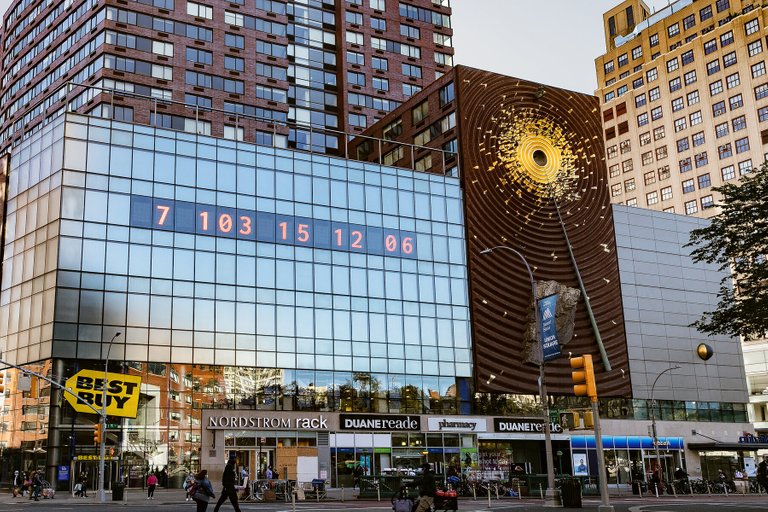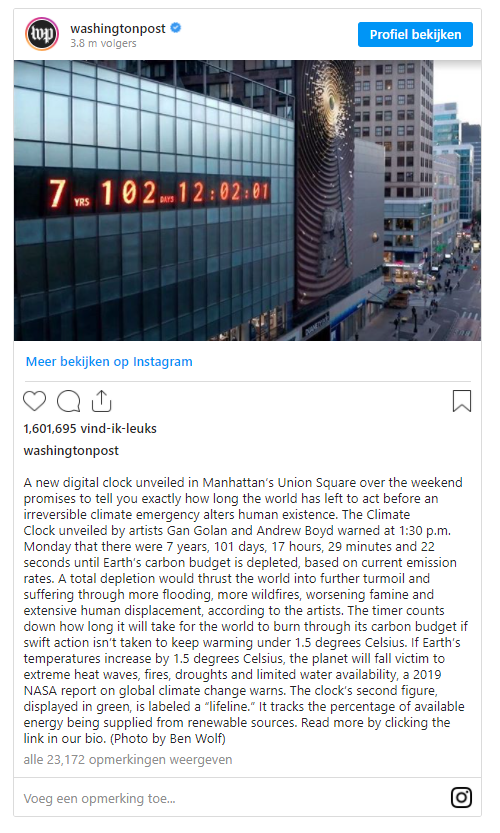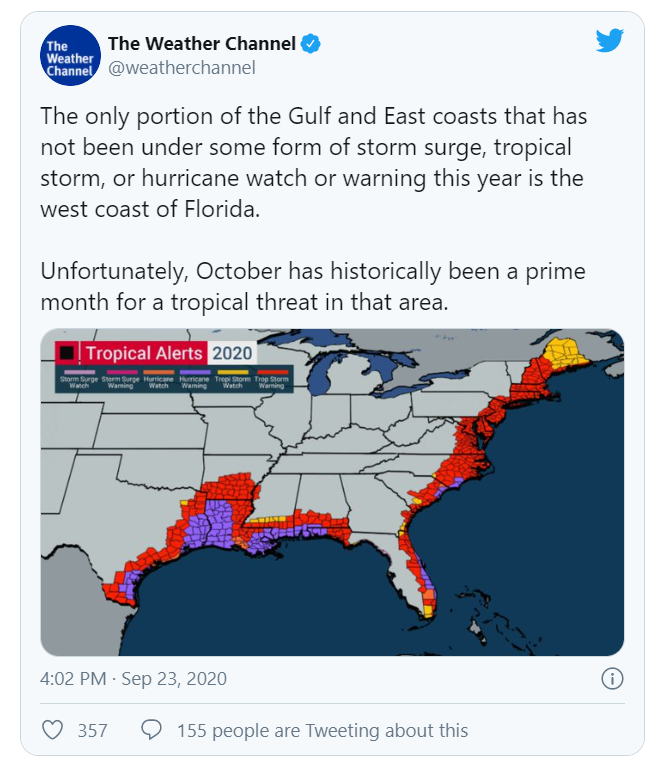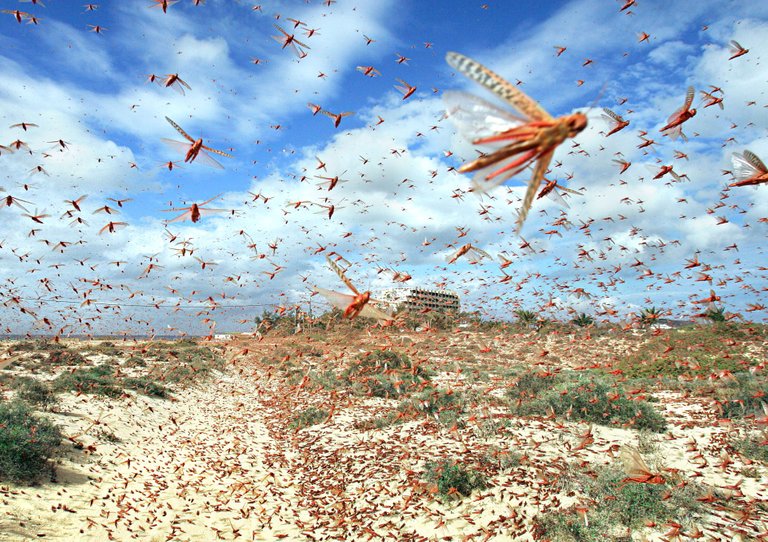
In the obsession with countdowns until the moment when the earth finds itself in an irreversible climate emergency, a real danger lurks. The illusion of time and the shifting of the problem denies the damage done now, here and everywhere.

On the occasion of climate week in New York two weeks ago, a gigantic digital 'climate clock' was shown on Union Square in Manhattan, counting down to when global warming would exceed 1.5°C and the carbon budget would be depleted. The clock indicates the time we have left to do something about it before an irreversible climate emergency occurs. The makers of the clock had the intention to raise awareness about the 'future' climate crisis.
Although artists Gan Golan and Andrew Boyd may have had good intentions, this climate clock is problematic and even dangerous. As many still seem to think, the climate crisis is not a future phenomenon; on the contrary, we are in the middle of it. In the first six months of 2020, 207 natural disasters were recorded worldwide, which is well above the average of 185 disasters in the previous two decades.

Not the only, but an important cause of this is the rising temperatures caused by global warming. Last summer in the Northern Hemisphere was the hottest summer since measurements began. In fact, the month of August this year was the second warmest August ever worldwide. Chances are that this year will be one of the five warmest years ever. Globally, temperatures are clearly rising, with obvious consequences. It has been happening for years in the South, increasingly in the North. Everywhere, here and now.
Some climate trends in a nutshell
The recent increase in forest fires worldwide will not have escaped anyone's notice. According to WWF, in April this year there was already a 13 percent increase in the number of forest fires compared to last year. And that increase cannot be explained by land management alone.
Although in South America, for example, the causes of the fires in the Pantanal and Argentina, among others, are complex, there are increasingly strong indications that the ever warmer and drier conditions caused by climate change are increasing the risk, frequency and severity of fires in various regions of the world.
We see this, for example, on the west coast of the United States, where in the state of California the average warming is already approaching 1.6 degrees Celsius and where there were huge heat waves last summer. As a result, the state had to deal with 8,200 forest fires this year. More than 1.5 million hectares of land were destroyed, 31 people died, entire neighborhoods were burnt down and more than 50,000 people were evacuated. And the fires are still raging. According to Cal Fire, California's fire department, we can't speak of a 'season' anymore, because it just lasts all year round. Tom Schwedhelm, mayor of Santa Rosa, says the following: "don't pretend that it's happening somewhere else and not here."
Siberia, too, was confronted with unseen heat waves that resulted in the worst fire season ever for the second time in a row, the end of which is not yet near. Satellites also showed that more sea ice melted in June this year than any other June ever. What's more, more than half of the Siberian hotbeds this year raged on permafrost with lots of ground ice, which stores huge amounts of carbon from the old biomass. The thawing of this permafrost releases unprecedented amounts of methane and CO2, which in turn contribute to global warming. A vicious circle.
2020 perhaps the most active hurricane season in decades
Not to mention the Atlantic hurricane season, which has recently surpassed the normal list of names so that one already has to use the Greek alphabet. The World Meteorological Organization uses a list of names in alphabetical order (Q, U, X, Y and Z are omitted to avoid confusion) which one uses again every six years. In 2005, six names were already used with this alphabet, a year with enormously devastating hurricanes such as Katrina, but now this happens even earlier in the hurricane season.
The season runs from 1 June to 30 November each year and this year the hurricanes change very fast. The twentieth hurricane was already there on September 14 this year, making it the earliest twentieth hurricane in the year ever. So far, 24 tropical storms have passed, of which eight hurricanes and two enormously heavy hurricanes. In an average season these are 12 storms, six hurricanes and three heavy hurricanes. And this too has to do with increasingly higher temperatures.
Climate is not the only factor, but an important one in the formation of hurricanes and storms. Unusually warm temperatures on the surfaces of our oceans and calm atmospheric conditions in spring and summer were the ideal conditions for both the formation of tropical hurricanes and their intensity. The warmer the water, the more energy is available for hurricanes to turn, grow and become stronger.

Locust plague from the Horn of Africa to Southwest Asia
Higher temperatures have also led to more cyclones in the Indian Ocean in the past three years. The resulting heavier rainfall and warmer temperatures are ideal breeding conditions for locusts, resulting in larger swarms. The outbreaks usually occur during periods of heavy rainfall, but the current outbreak is of particular concern. For example, the Horn of Africa has been ravaged by the worst locust invasion in seventy years since April and stretched from Kenya to Pakistan and India.
In addition to the direct impact of the climate crisis and the number of deaths due to natural disasters caused by the crisis, the climate crisis is also exacerbating already existing pernicious conditions such as crop failures, hunger and poverty. As many as 4.9 million people are at risk of starvation due to the current swarms of locusts, and despite efforts to slow down crop losses, the Food and Agriculture Organization of the United Nations (FAO) expects the damage to continue.

Parkinson's law
This summary of notable climate events that do not occur in isolation but are clearly related to each other is not an exhaustive list, nor is everything said in this way. What is clear, however, is that such clocks are downright dangerous. To illustrate this, Parkinson's law seems interesting.
That law says that "work expands so as to fill the time available for its completion", which means that if we are presented with a deadline - as in this case with a climate clock - we systematically ignore the havoc and the increasing number of victims caused by the climate crisis in the past, today and at this moment.
The climate problems that the most vulnerable people and those with no voice have been facing for years are thus considered unimportant and the emphasis shifts to the time we have left to do nothing, so to speak.
For those who have been suffering for a long time worldwide from serious climate disasters, which, moreover, are occurring on an increasingly large scale and also in the North, the figure of 1.5 degrees Celsius is not significant. They are already in the middle of it. We are all in the middle of it. That's why a clock, countdowns or any other way of getting the idea that we still have seven years before we have to get going is a very bad idea.
For those who have been displaced worldwide, had to flee or lost their livelihoods or lives, this countdown is nothing more than a reinforcement of their perception that the battle they are waging against the climate crisis is unimportant. The obsession with countdowns creates a shift in the problem and an excuse for the powerful sectors, governments and privileged people who see the climate crisis, with all its consequences, as a non-urgent problem for the future.
